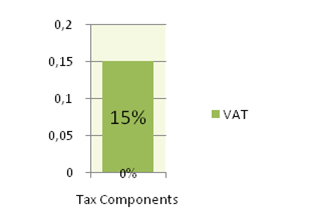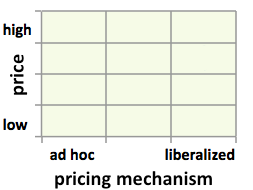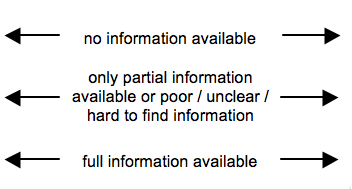Knowledge fuels change
For over a decade, Energypedia has shared free, reliable energy expertise with the world.
We’re now facing a serious funding gap.
Help keep this platform alive — your donation, big or small, truly matters!
Thank you for your support
Difference between revisions of "Fuel Prices Mexico"
***** (***** | *****) m |
***** (***** | *****) |
||
| (17 intermediate revisions by 3 users not shown) | |||
| Line 1: | Line 1: | ||
{{Fuel Price Factsheet | {{Fuel Price Factsheet | ||
|Fuel Price Country=Mexico | |Fuel Price Country=Mexico | ||
| + | |Fuel Pricing Policies=Pricing: Retail price adjustments are decoupled from world price movements and smoothed by adjusting the special tax on production and service. For gasoline and diesel, this tax was negative for three years until May 2009, when it became positive gasoline, and has been negative since Jun 2009 for gasoline and since Jul 2009 for diesel. In 2012, the special tax averaged –US$0.22/liter for regular gasoline, –US$0.23 for diesel, and –US$0.30 for premium gasoline. Regular gasoline and diesel prices were raised at a nominal annual rate of 10–11% in 2010, 2011, and 2012. In 2007, the price of diesel rose by only 4% and gasoline by 5%. The price of regular gasoline grew at only 7% in 2008 and 6% in 2009, but the price of diesel rose by 21% and 16%, respectively. The pace of increase has not been enough to catch up with rising world prices since 2010. Monthly average retail diesel prices and benchmark FOB prices relevant to Mexico are shown below. It is clear that, although not as large as in 2008, a sizable subsidy continues. When the benchmark LPG prices in Belvieu, Texas, United States, are high, LPG prices in Mexico are kept below import-parity levels, despite Mexico’s being a large net importer of LPG. Under Mexico’s climate law, passed in Apr 2012 and only the second in the world after UK’s Climate Change Act of 2008, government will formulate rules to phase out fossil fuel subsidies. | ||
| + | |||
| + | Consequences of subsidies: The annual implicit subsidy in 2011 for LPG alone amounted to MXN40 billion (US$3.2 billion). Pemex has had trouble moving refinery projects forward, turning Mexico into a significant importer of petroleum products. | ||
| + | |||
| + | Hedging: Although different from hedging petroleum product prices to protect consumers, Mexico hedges crude exports every year to protect fiscal revenues. Government achieved remarkable success by hedging crude oil exports in 2009, spending US$1.5 billion for hedging contracts and earning US$5 billion in return. | ||
| + | |||
| + | Information: Ministry of Energy posts detailed price information on petroleum products. For LPG, Ministry of Energy regulates transport and distribution tariffs, and Ministry of Economy gazettes maximum consumer prices in 145 distribution zones every month." | ||
| + | |||
| + | (Source: Kojima, Masami. (2013, forthcoming). “Petroleum product pricing and complementary policies:Experience of 65 developing countries since 2009.” Washington DC: World Bank.) | ||
|Fuel Currency=MXN | |Fuel Currency=MXN | ||
|Fuel Price Exchange Rate=12.483 | |Fuel Price Exchange Rate=12.483 | ||
| Line 10: | Line 19: | ||
|Fuel Price Composition 2=GIZ_IFP2012_Mexico2.png | |Fuel Price Composition 2=GIZ_IFP2012_Mexico2.png | ||
|Fuel Price Composition Annotation 2=Tax info: http://www.economywatch.com/business-and-economy/mexico.html | |Fuel Price Composition Annotation 2=Tax info: http://www.economywatch.com/business-and-economy/mexico.html | ||
| − | |||
| − | |||
| − | |||
| − | |||
| − | |||
| − | |||
| − | |||
| − | |||
| − | |||
| − | |||
| − | |||
| − | |||
| − | |||
| − | |||
| − | |||
|Fuel Matrix Pricing Mechanism=2 | |Fuel Matrix Pricing Mechanism=2 | ||
|Fuel Matrix Price Level=2 | |Fuel Matrix Price Level=2 | ||
| Line 54: | Line 48: | ||
|Fuel Price Factsheet Source Annotation=Ministry of Finance and Public Credit | |Fuel Price Factsheet Source Annotation=Ministry of Finance and Public Credit | ||
}} | }} | ||
| + | {{Fuel Price Factsheet Source | ||
| + | |Fuel Price Factsheet Source Type=Price Composition | ||
| + | |Fuel Price Factsheet Source Link=http://bit.ly/1MvQkES | ||
| + | |Fuel Price Factsheet Source Annotation=SECRETARÍA DE ENERGÍA, MÉXICO | ||
| + | }} | ||
| + | |||
| + | [[Category:Mexico]] | ||
Latest revision as of 14:56, 12 March 2015
Part of: GIZ International Fuel Price database
Also see: Mexico Energy Situation
Fuel Pricing Policies
| Local Currency: | MXN |
| Exchange Rate: | 12.483
|
| Last Update: |
Pricing: Retail price adjustments are decoupled from world price movements and smoothed by adjusting the special tax on production and service. For gasoline and diesel, this tax was negative for three years until May 2009, when it became positive gasoline, and has been negative since Jun 2009 for gasoline and since Jul 2009 for diesel. In 2012, the special tax averaged –US$0.22/liter for regular gasoline, –US$0.23 for diesel, and –US$0.30 for premium gasoline. Regular gasoline and diesel prices were raised at a nominal annual rate of 10–11% in 2010, 2011, and 2012. In 2007, the price of diesel rose by only 4% and gasoline by 5%. The price of regular gasoline grew at only 7% in 2008 and 6% in 2009, but the price of diesel rose by 21% and 16%, respectively. The pace of increase has not been enough to catch up with rising world prices since 2010. Monthly average retail diesel prices and benchmark FOB prices relevant to Mexico are shown below. It is clear that, although not as large as in 2008, a sizable subsidy continues. When the benchmark LPG prices in Belvieu, Texas, United States, are high, LPG prices in Mexico are kept below import-parity levels, despite Mexico’s being a large net importer of LPG. Under Mexico’s climate law, passed in Apr 2012 and only the second in the world after UK’s Climate Change Act of 2008, government will formulate rules to phase out fossil fuel subsidies.
Consequences of subsidies: The annual implicit subsidy in 2011 for LPG alone amounted to MXN40 billion (US$3.2 billion). Pemex has had trouble moving refinery projects forward, turning Mexico into a significant importer of petroleum products.
Hedging: Although different from hedging petroleum product prices to protect consumers, Mexico hedges crude exports every year to protect fiscal revenues. Government achieved remarkable success by hedging crude oil exports in 2009, spending US$1.5 billion for hedging contracts and earning US$5 billion in return.
Information: Ministry of Energy posts detailed price information on petroleum products. For LPG, Ministry of Energy regulates transport and distribution tariffs, and Ministry of Economy gazettes maximum consumer prices in 145 distribution zones every month."
(Source: Kojima, Masami. (2013, forthcoming). “Petroleum product pricing and complementary policies:Experience of 65 developing countries since 2009.” Washington DC: World Bank.)
Fuel Prices and Trends
| Gasoline 95 Octane | Diesel | |
|---|---|---|
| in USD* |
|
|
| in Local Currency |
|
|
* benchmark lines: green=US price; grey=price in Spain; red=price of Crude Oil
Fuel Price Composition
Price composition for one litre of Gasoline 95 Octane as of 2010/11/01.


No further information available.
Tax info: http://www.economywatch.com/business-and-economy/mexico.html
At a Glance
| Regulation-Price-Matrix |
| ||||
 |

|

|

| ||
Sources to the Public
| Type of Information | Web-Link / Source |
|---|---|
| Other Information | http://www.cre.gob.mx (Energy Regulatory Commission) |
| Other Information | http://www.onexpo.com.mx (National Organisation of Petroleum Expenders) |
| Other Information | http://www.pemex.com/ (Petroleos Mexicanos) |
| Other Information | http://www.shcp.gob.mx (Ministry of Finance and Public Credit) |
| Price Composition | http://bit.ly/1MvQkES (SECRETARÍA DE ENERGÍA, MÉXICO) |
| Pump prices and margins | http://www.ri.pemex.com/files/dcpe/petro/epublico_esp.pdf |
Contact
Please find more information on GIZ International Fuel Price Database and http://www.giz.de/fuelprices
The following coordinate was not recognized: {{#geocode: Mexico|google }}.



















